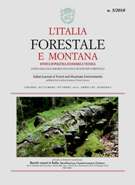Special section
Published 2013-05-16
Keywords
- old-growth forest,
- rarefaction curves,
- forest management,
- functional traits,
- permutational multivariate analysis of variance
Copyright (c) 2013 Italian Journal of Forest and Mountain Environments

This work is licensed under a Creative Commons Attribution-NonCommercial 4.0 International License.
Abstract
Vascular plants understorey of an old-growth beech forest was compared to a managed stand, similar for biogeographical, climatic and abiotic features. Parametric testsand accumulation and rarefaction curves were used to compare the stands in terms of vascular plant diversity at stand level and among sampling units.
The sampled understorey species were characterized in terms of functional traits and Ellenberg’s indicator values; next, we calculated four different pairwise plot-to-plot dissimilarity matrices based on: 1. species presence/absence, 2. cover values, 3. functional traits and 4. Ellenberg’s indices. We applied a permutational multivariate extension of ANOVA to test whether the forest stands significantly differ in the considered features.
Furthermore we used fourth corner analysis to highlight which single functional trait is significantly associated to each stand.
Although not richer at plot level the old-growth stand resulted more diverse both at stand level and in terms of among-plots diversity than the managed one. All the comparisons performed through permutational multivariate ANOVA showed significant
differences, with the exception of the one based on Ellenberg’s indices.
From a functional and ecological perspective in the old-growth forest we noted: 1. a relative increase of hemicryptophyte species with limited dispersal abilities (antdispersed
or non specialized); 2. a decrease in early-flowering geophytes; 3. a parallel increment in small seeded, wind-dispersed species adapted to relatively open and bright conditions (gaps).
Our results suggest that in the old-growth stand the high vertical and horizontal structural heterogeneity of the canopy modulates the ecological conditions at the forest
floor and increases the environmental heterogeneity. This mechanism is likely to allow the coexistence of a higher number of species, with different ecological requirements.

